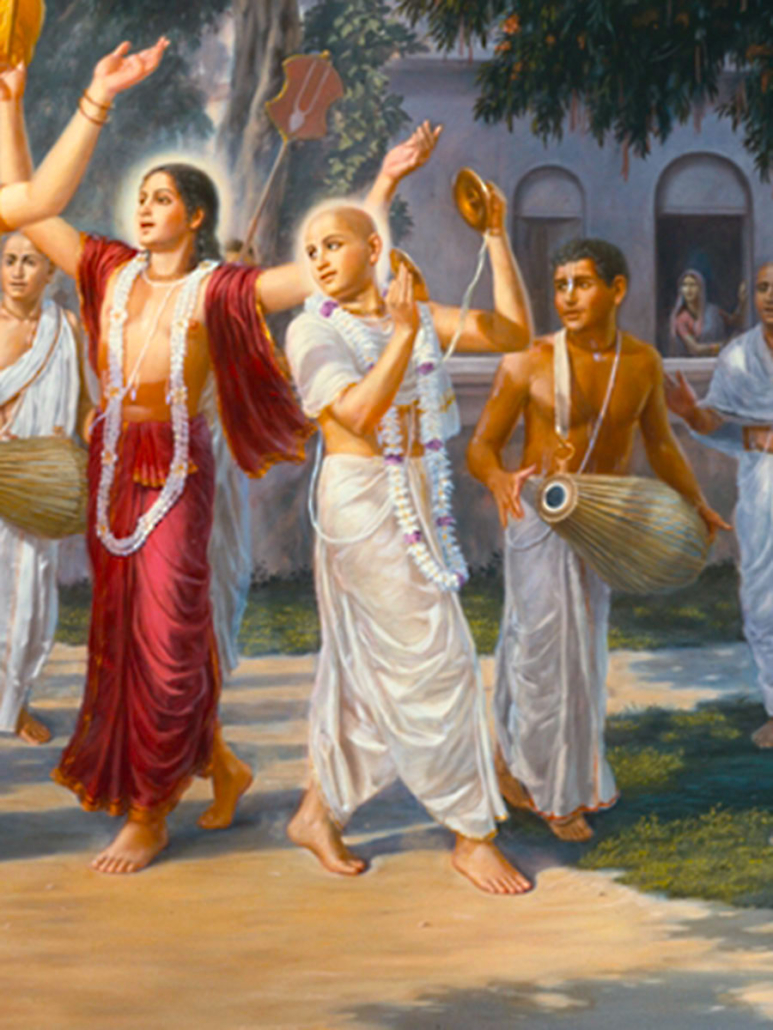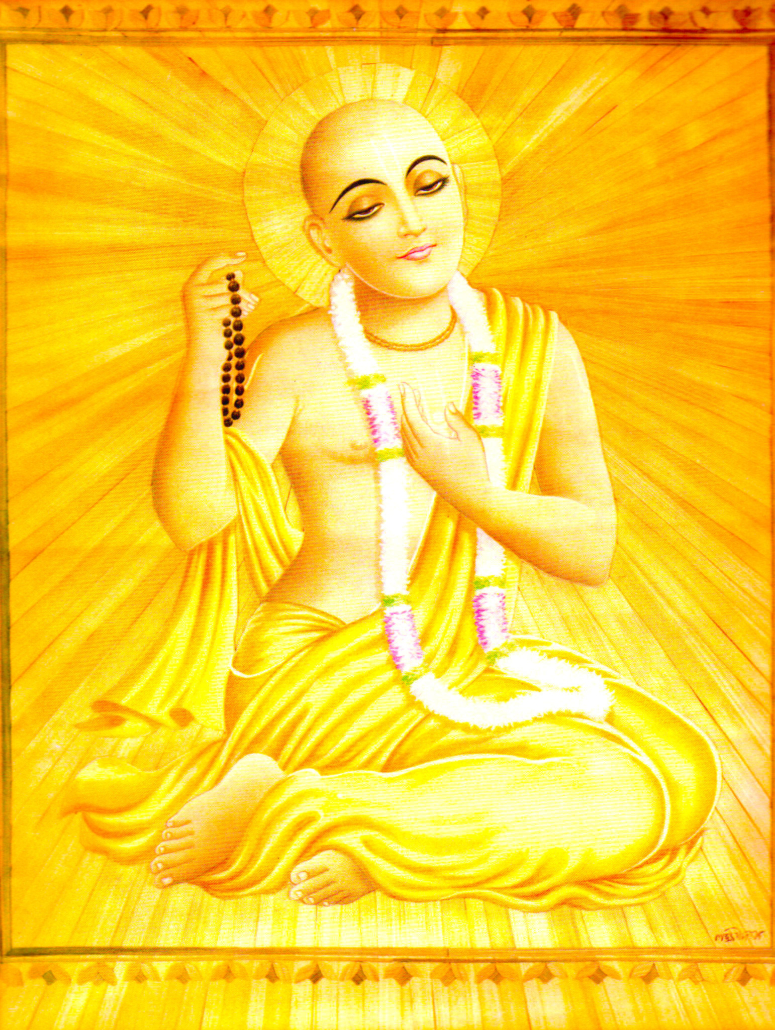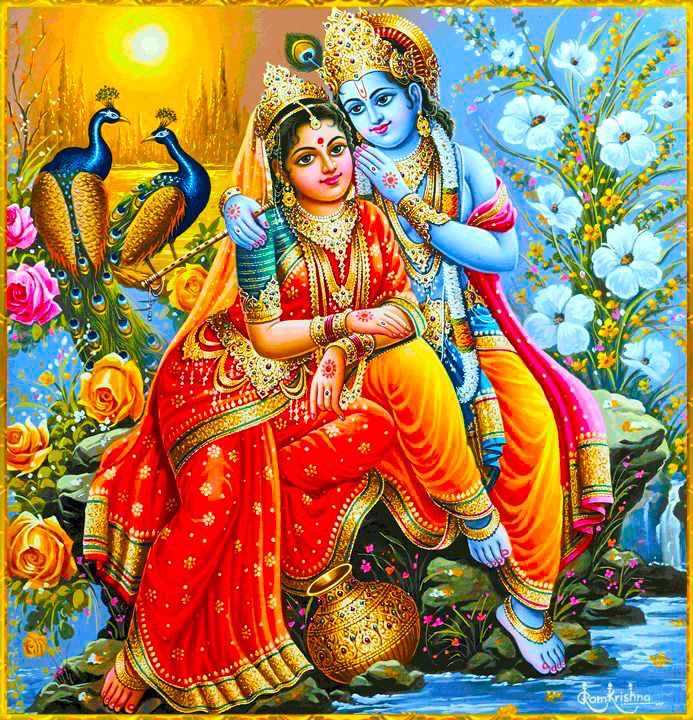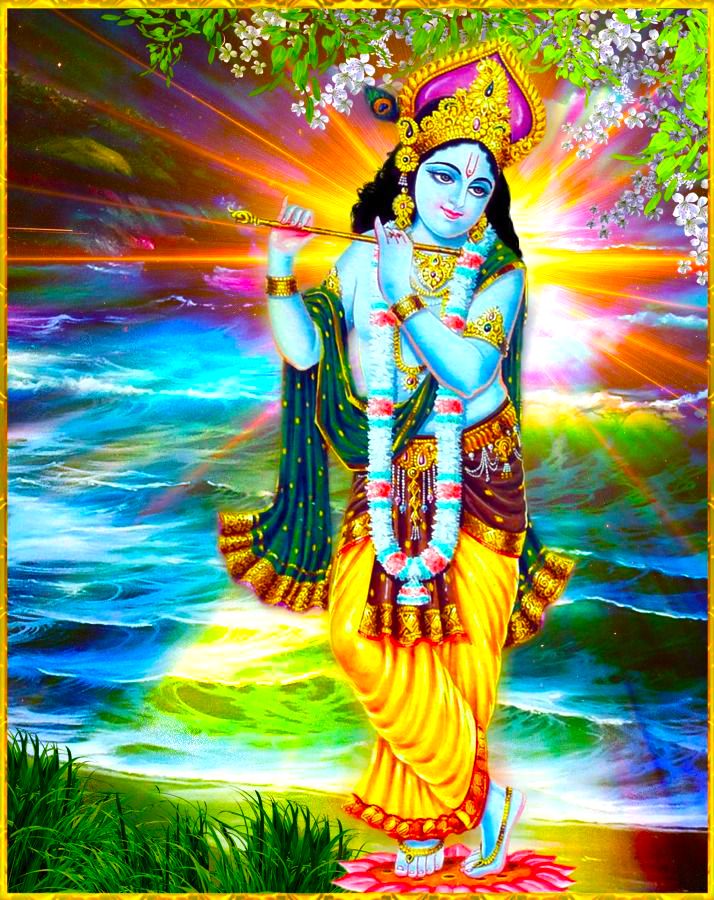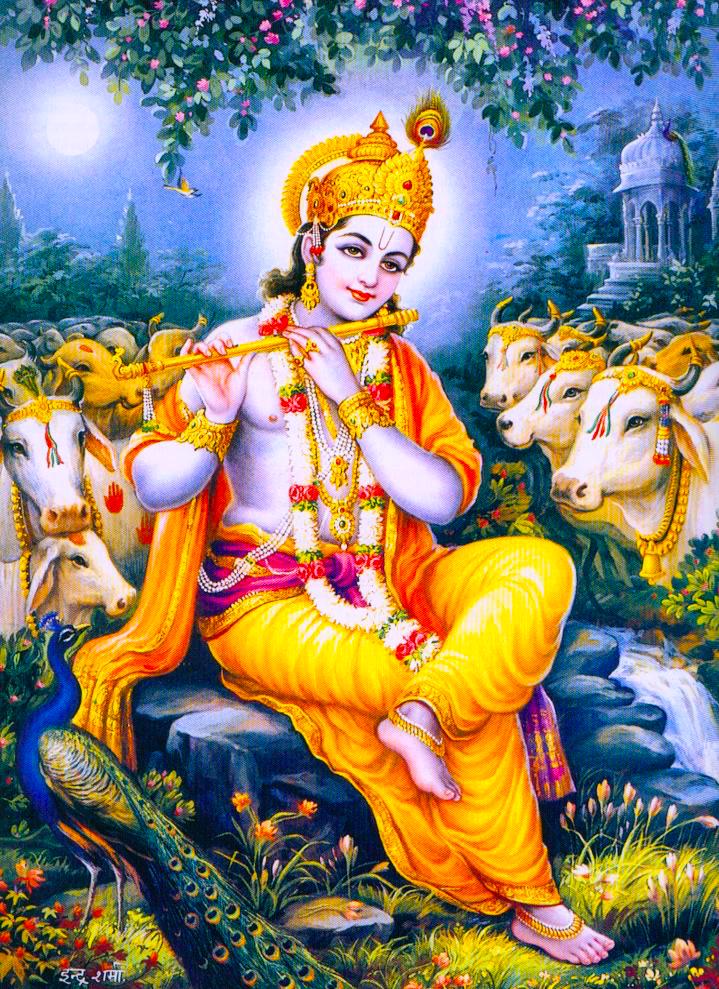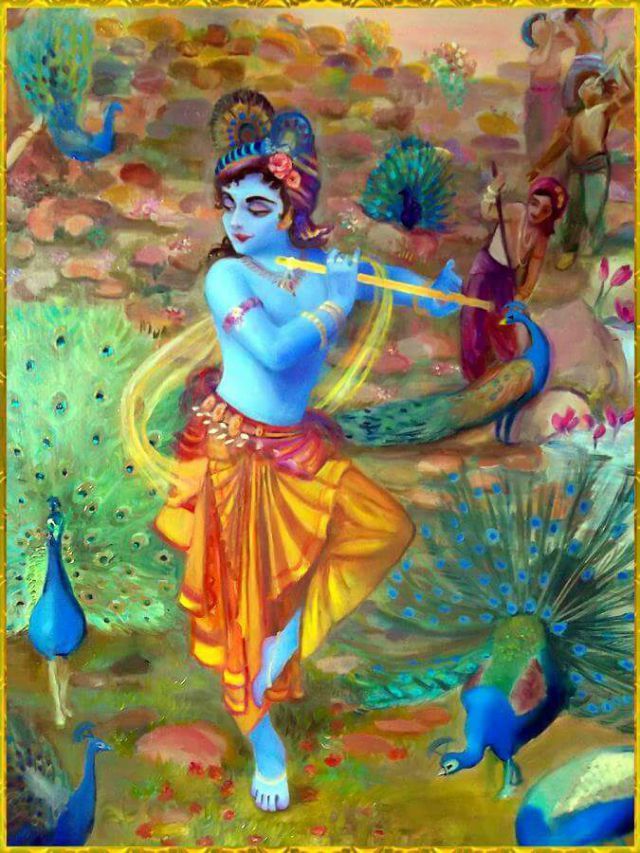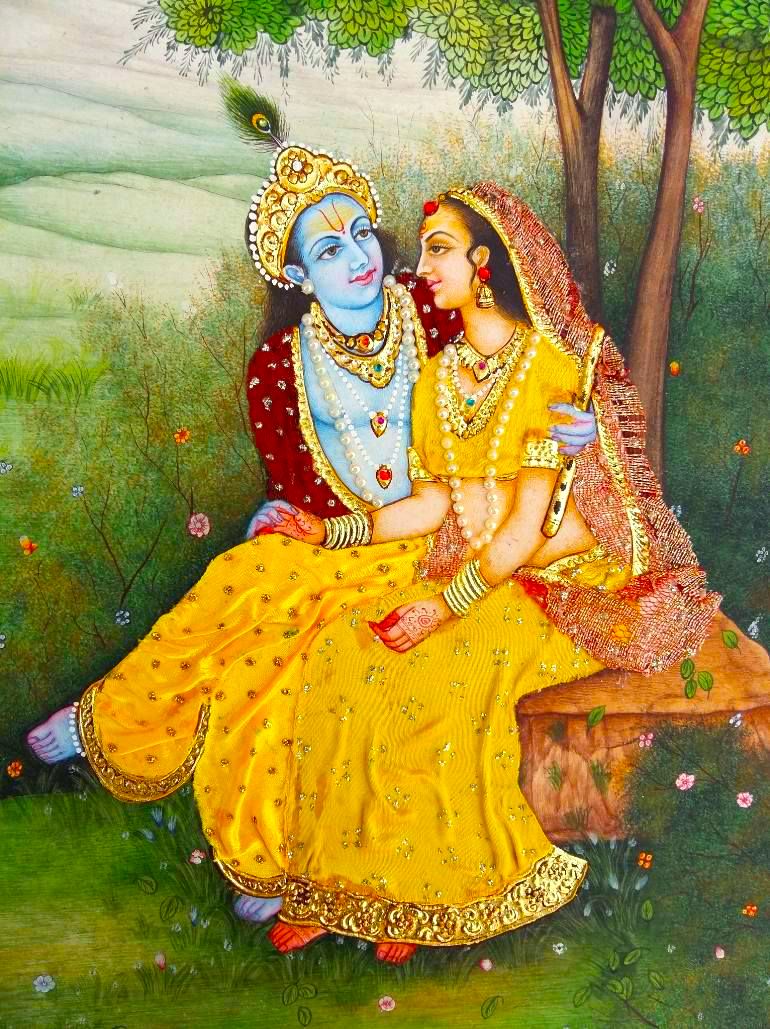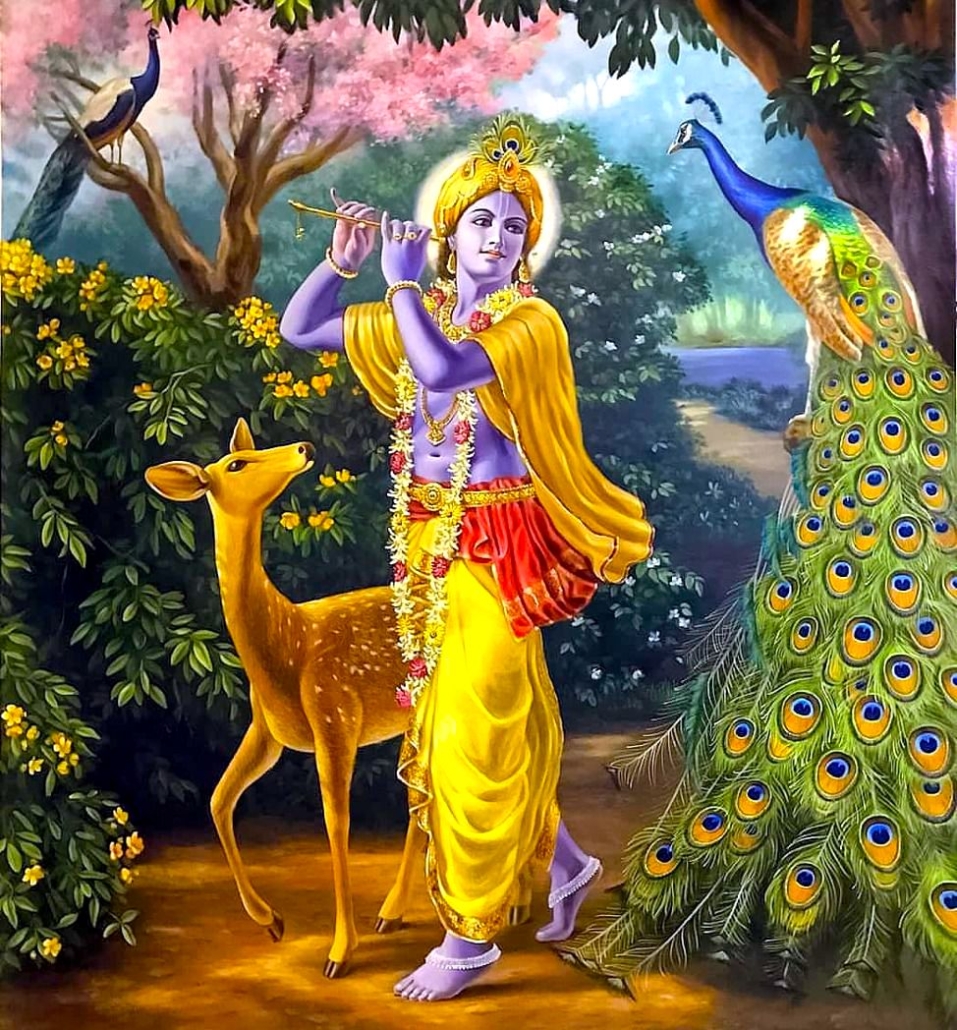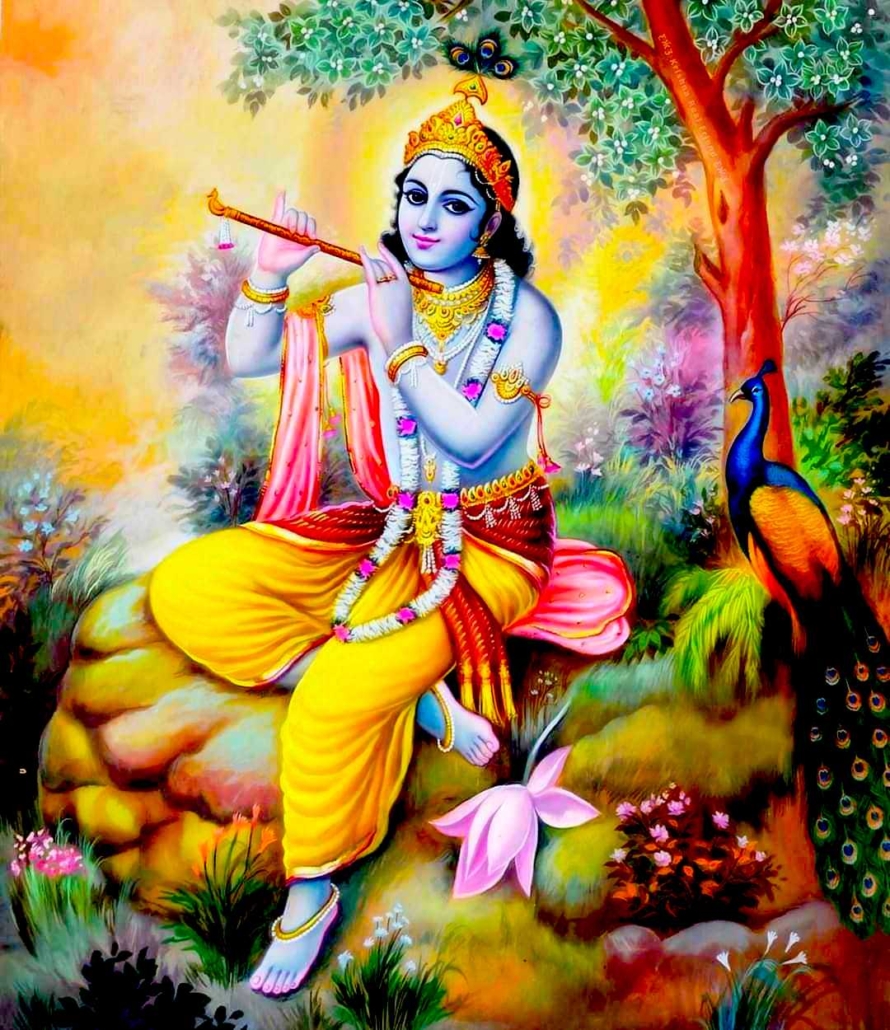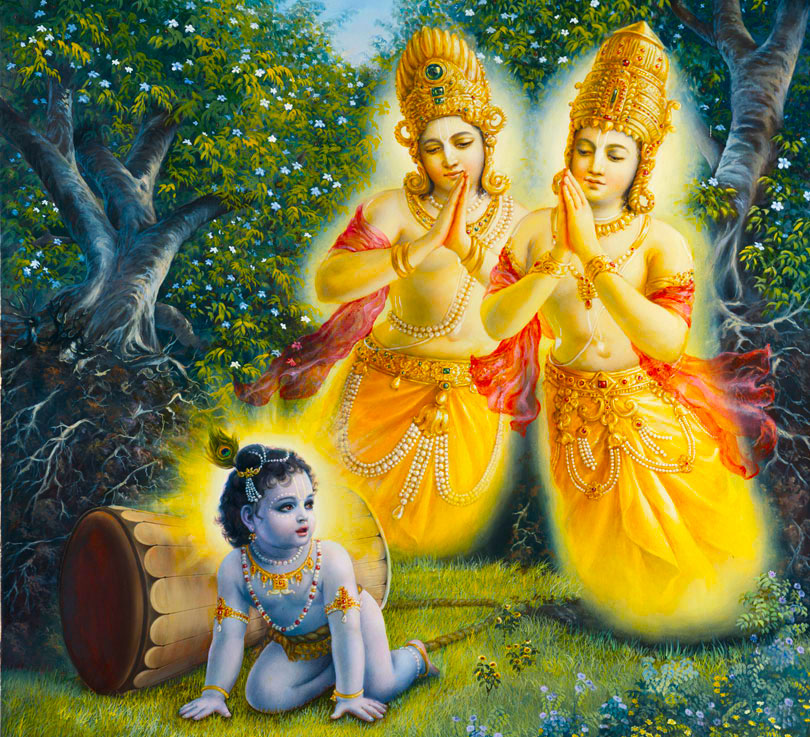Mahanidhi Madan Gopal Das
Mahanidhi Madan Gopal Das
Five hundred years ago in Jagannatha Puri, Sarvabhauma Bhattacarya asked Sri Caitanya Mahaprabhu which item is the most important form of devotional service.
bhakti-sādhana-śreṣṭha śunite haila mana
prabhu upadeśa kaila nāma-saṅkīrtana
harer nāma harer nāma, harer nāmaiva kevalam
kalau nāsty eva nāsty eva, nāsty eva gatir anyathā
Sarvabhauma Bhaṭṭācārya asked Caitanya Mahāprabhu, ‘Which item is most important in the execution of devotional service?’ Mahaprabhu replied that the most important item was the chanting of the holy name of the Lord. Then Mahaprabhu quoted a verse from Bṛhan-nāradīya Purāṇa:
‘In this age of quarrel and hypocrisy, the only means of deliverance is the chanting of the holy names of the Lord. There is no other way. There is no other way. There is no other way.’ (Caitanya Caritamrita, Madhya 6.241-2)
Sri Caitanya Mahaprabhu always emphasized the supremacy of nama-bhajana in His preaching. In Jagannatha Puri, Mahaprabhu also instructed Sanatana Gosvami on this point:
bhajanera madhye śreṣṭha nava-vidhā bhakti
‘kṛṣṇa-prema’, ‘kṛṣṇa’ dite dhare mahā-śakti
tāra madhye sarva-śreṣṭha nāma-saṅkīrtana
niraparādhe nāma laile pāya prema-dhana
Of all the different spiritual practices, the nine forms of bhakti (sravanam, kirtanam, etc) are the best because they have great potency to deliver Kṛṣṇa and ecstatic love for Him. Of these nine practices, nama-sankirtana is the best. By chanting the holy name without offense, one very easily obtains the priceless treasure of kṛṣṇa-prema. (Caitanya Caritamrita, Antya 4.70-1)
“The Caitanya-caritāmṛta states that of the nine ways of devotional service to obtain love of God, the foremost is nāma-saṅkīrtana. One who chants nāma without offenses surely achieves love of God. Bhakti-sandarbha says no form of bhakti (i.e. mathurā-vāsa, sādhu-saṅga, srī-murti sevā, and bhāgavata-sravana) is complete without Śrī Kṛṣṇa nāma-saṅkīrtana. The Hari-bhakti-sudhodaya says that saṅkīrtana is the best and foremost of all spiritual practices for attaining Kṛṣṇa’s mercy. If the other practices of bhakti are helpful to it, they should then be accepted.” (Sri Caitanya’s Teachings)
“Sri-nama bhajana is more powerful than all other forms of bhajana (nava-vidha-bhakti). There is no difference between nama (the holy name) and nami (Bhagavan, who possesses the name.) If you chant nama without offense, you will very quickly attain all perfection. All nine forms of bhajana are automatically carried out by performing nama-bhajana. When one utters sri-nama, he is engaged in hearing and chanting (sravanam, kirtanam). As one continues to chant, one also remembers the pastimes of Kṛṣṇa, and within the mind one serves Kṛṣṇa’s lotus feet (pada-sevanam), worships Him (arcanam), offers prayers (vandanam), serves Kṛṣṇa in the mood of a servant (dasyam) or friend (sakhyam), and offers one’s very self to Kṛṣṇa (atma-nivedanam).” (Jaiva Dharma ch. 4)
Upon completing the description of the sixty-four limbs of devotional service, Śrīla Rūpa Gosvāmī mentions five of them as the most important items. Śrīla Bhaktisiddhānta Sarasvatī Ṭhākura clearly shows how each one of these five most potent devotional processes points to the chanting of the holy name.
Sarasvatī Ṭhākura once explained that after careful consideration of the five limbs of bhakti, the best practice is srī-nāma bhajana. The next entry shows how chanting Kṛṣṇa’s holy names is the root of all nine forms of devotion and is glorified above all.
(1) Sādhu-saṅga–associating with devotees is recommended to create a taste or inclination for srī-nāma bhajana. This comes from associating with holy saints who are attached to chanting Kṛṣṇa’s holy names with firm faith and who systematically chant the names.
(2) Bhāgavata-śravaṅa–hearing Śrīmad Bhāgavatam which itself declares sri-nāma bhajana to be the highest virtue. In its beginning, middle (sixth canto, Ājamila story), and end, the Śrīmad Bhāgavatam repeatedly stresses the efficacy of sri-nāma bhajana.
(3) Mathurā-vāsa–sri-nāma bhajana is situated at the root of residence in Vṛndāvana or Śrīdhāma Māyāpur. The sādhus living in or visiting these holy places are always engaged in nāma-saṅkīrtana.
(4) Śrī-murti-sevā–the service of Kṛṣṇa’s Deity is always conducted with mantras full of God’s names. The Hari-bhakti-vilāsa and Śrī Jīva Gosvāmī say that Deity service must be accompanied with chanting the Hare Kṛṣṇa mantra for it to be accepted.
(5) Nāma-saṅkīrtana–is directly chanting the holy names.
“Of all means of bhajana (devotional service), the name of Kṛṣṇa is most purely spiritual. In describing the absolute duties, Hari-bhakti-vilāsa states that singing and meditating on Śrī Nāma (Kṛṣṇa’s holy names) is the best devotional activity.
“The most advanced devotees who have fully dedicated themselves to Śrī Kṛṣṇa take exclusive refuge in kṛṣṇa-nāma amongst all other practices of devotion. There is no other performance so pure and spiritual as singing the name of Kṛṣṇa.” (Nama-bhajana)
According to Sri Jiva Gosvami, chanting the holy name is not only the greatest form of sadhana, but it must accompany every other form of devotional service: “Chanting the holy name of Kṛṣṇa is the chief means of attaining love of God. This chanting does not depend on any paraphernalia, nor birth in a good family. All the Vedas proclaim that by humility and meekness one attracts the attention of Kṛṣṇa. Therefore, chanting Hare Kṛṣṇa is the greatest sadhana (mahā-sādhanānam), and the fulfillment of all sacrifice, penance and austerities. Simply by chanting one achieves ecstatic love of God and complete perfection in life. Therefore, whatever one does in executing devotional service must be accompanied with the chanting of the holy name.” (Bhakti-sandarbha 270)
An excerpt from the book Art of Chanting
Mahanidhi Madan Gopal Das
kṛṣṇa-mantra haite habe saṁsāra-mocana,
kṛṣṇa-nāma haite pābe kṛṣṇera caraṇa
Sri Caitanya Mahaprabhu said, “The kṛṣṇa mantra (gopala mantra) gives one freedom from material existence. And kṛṣṇa nama (the Hare Kṛṣṇa maha-mantra) delivers one to the lotus feet of Kṛṣṇa.” (Caitanya Caritamrita Ādi 7.73)
In this verse, Lord Caitanya describes the effects of chanting the eighteen-syllable gopala mantra and the Hare Kṛṣṇa maha-mantra. Of the two mantras, Sri Jiva Gosvami emphasizes chanting the Hare Kṛṣṇa maha-mantra in Bhakti Sandarbha 284: “Mantras are actually composed of the names of the Supreme Lord. Mantras are distinct from the name because they include the word “namah” [or svaha], and have special powers that are given by the rsis or the Lord Himself. The holy names of the Lord, however, in themselves, being independent, can bestow the higest goal of life, Kṛṣṇa-prema. Thus the names of Kṛṣṇa are more suitable than mantras.”
In Kṛṣṇa Samhita, Srila Bhaktivinoda Thakura describes the various mantras given to liberate one in the different yugas. In Satya, Treta and Dvapara yugas these mantras, called tāraka-brahma-nāma, addressed the Supreme Lord with feelings of awe and reverence invoking His divine power, majesty and protection (aisvarya-bhava). The tāraka-brahma-nāma for Kali-yuga is the Hare Kṛṣṇa maha-mantra, a selfless call for loving service.
In the Gaudiya conception, samsara-mocana, or liberation means to realize one’s svarupa. At this stage, the Brahma Gayatri and the gopala mantra retire, but chanting Hare Kṛṣṇa continues to deliver one to the lotus feet of Kṛṣṇa (kṛṣṇa-carana), in the spiritual world. This is the final stage of spiritual evolution wherein one attains his vastu siddhi, (pure spiritual form), and engages in Kṛṣṇa’s eternal service.
Whether one is in Kṛṣṇaloka or the material world, chanting Kṛṣṇa’s holy name is the eternal function of the soul. In the material world, chanting Hare Kṛṣṇa is the primary activity for purification and spiritual elevation. Everything else is auxiliary or supportive of the main service of chanting Hare Kṛṣṇa. Upon entering the spiritual world, however, chanting the holy name will be in the background, helping and energizing. Serving Radha-Govinda will be in the foreground, distinct and most important. For example, when the gopīs churn fresh yogurt for Kṛṣṇa’s butter, they simultaneously sing His glories while keeping time with their bangles and waistbells.
An excerpt from the book Art of Chanting
Mahanidhi Madan Gopal Das
“Kṛṣṇa-nāma has been accepted by all to be an incarnation of Lord Śrī Kṛṣṇa on this earth. Although He appears like a word, Kṛṣṇa, still by His inconceivable power He is completely spiritual. The name is a special incarnation of the Supreme Personality of Godhead. As Kṛṣṇa and His name are identical, Kṛṣṇa has descended to earth as nāma. Kṛṣṇa-nāma is our first introduction to Kṛṣṇa. Therefore, we first meet Kṛṣṇa in His name. With determination to reach Kṛṣṇa, we must first accept the name of Kṛṣṇa.” (Nama Bhajana)
“Nāma is also another incarnation of Kṛṣṇa. Nāma-rūpe kali-kāle kṛṣṇa-avatāra. Because name and Kṛṣṇa are not different. Abhinnatvād nāma-nāminoḥ. There is no difference. In the material world there is difference between the name and the substance. But in advaya-jñāna, the Absolute world, there is no such distinction. The name and the person are the same, identical.” (SPT 30/10/72)
How does Hare Kṛṣṇa japa purify the chanter? “Chanting gradually diminishes the propensity to sin, and simultaneously purifies the consciousness. At this juncture, a taste for chanting begins to manifest. The inclination to commit sinful acts vanishes, though a faint residue of previous sinful acts still lingers in the consciousness. The receding sinful reactions leave an odor of sinful habits. But the chanter’s contact with the name produces a purity of mind and strength of willpower that overcomes the clinging smell of sin.” (Hari-nama-cintamani)
An excerpt from the book Art of Chanting
Mahanidhi Madan Gopal Das
Kṛṣṇa’s holy name–full of mercy, full of compassion, full of affection, full of rasa and full of prema–is the rarest treasure in the world. Without hearing from sastra and saints, however, one can never understand the power, value and benefit of Sri Kṛṣṇa’s divine name, form, attributes, pastimes and holy abode (nama, rupa, guna, lila, dhama). Throughout the Vedas the transcendental glories of the holy name are recounted.
The following verse from the Padma Purana compares the holy name to a cintamani gem, a divine stone that can bestow one’s desired results. Such cintamani gems make up the transcendental land of Kṛṣṇaloka in the spiritual world. This verse clearly describes the transcendental identity of the holy name:
nāma cintāmaṇiḥ kṛṣṇaś, caitanya-rasa-vigrahaḥ
pūrṇaḥ śuddho nitya-mukto, ‘bhinnatvān nāma-nāminoḥ
The holy name of Kṛṣṇa is a transcendental wish-fulfilling gem (cintamani); it is the embodiment of all consciousness and sentiments; it is complete; it is pure; it is ever free because the name of Kṛṣṇa and Kṛṣṇa Himself are one and the same.
Srila Prabhupada gives a wonderful expanded translation of this verse:
“The holy name of Kṛṣṇa is transcendentally blissful. It bestows all spiritual benedictions, for it is Kṛṣṇa Himself, the reservoir of all pleasure. Kṛṣṇa’s name is complete, and it is the form of all the transcendental mellows. It is not a material name under any condition, and it is no less powerful than Kṛṣṇa Himself. Since Kṛṣṇa’s name is not contaminated by the material qualities, there is no question of its being involved with māyā. Kṛṣṇa’s name is always liberated and spiritual. It is never conditioned by the laws of material nature. This is because the name of Kṛṣṇa and Kṛṣṇa Himself are identical.” (Caitanya Caritamrita Madhya 17.133 p.)
The following story from Vaisnava tradition illustrates the incomparable value of Kṛṣṇa’s holy name.
Once a disciple asked his guru for the topmost secret of bhajana. The guru replied, “The most confidential secret of bhajana is to always chant the maha-mantra–Hare Kṛṣṇa Hare Kṛṣṇa Kṛṣṇa Kṛṣṇa Hare Hare, Hare Rama Hare Rama Rama Rama Hare Hare!”
After leaving his guru’s asrama, the disciple met some poor washermen who were chanting Hare Kṛṣṇa while scrubbing clothes beside the Yamuna. He then heard some little girls chanting Hare Kṛṣṇa while collecting cow dung. When the disciple hired a ricksaw, the skinny old driver chanted Hare Kṛṣṇa all the way back to the asrama.
Meeting his guru, the disciple expressed a doubt about the maha-mantra, “Gurudeva! What kind of secret have you given to me that is known to every dhobi, ricksaw-walla and little girl in India? Is this really the most confidential secret of bhajana?”
Instead of a long explanation, the guru handed the disciple a precious jewel and said, “Show this jewel to the dhobi, ricksaw-walla and little girls, and see if they appreciate its value.” The disciple then showed the priceless jewel to the illiterate washermen, but they could not detect the value of the jewel. They said they would gladly accept it, and use it for beating their dirty cloth. The disciple refused to give them the gem, saying, “You have to pay the proper price for it. A stone or piece of wood is sufficient for beating dirty cloth.”
Upon seeing the jewel, the ricksaw-walla said, “Since it is a little rough, I think it is just suitable for scraping off the dry skin from my feet.” “Are you crazy!” said the disciple as he walked on to show the village girls. Failing to recognize the true worth of the jewel, the girls said, “We could use the jewel to pack our cow dung.”
The disciple again met with his guru and said, “Gurudeva! Nobody wanted to pay the proper price for the jewel. Nor could anyone appreciate the great value of the gem.”
“Yes, in the same way,” said the guru, “most people cannot appreciate the value of the holy name. For this reason, they are indifferent to the chanting of Hare Kṛṣṇa. The Hare Kṛṣṇa maha-mantra is an open secret that is revealed only to the qualified.”
An excerpt from the book Art of Chanting
Mahanidhi Madan Gopal Das
The Kaustubha jewel is an eternal, uniquely distinguishing necklace adorning the beautiful transcendental bodies of both Bhagavan Sri Krishna and Sri Vishnu.
But did you know that Kaustubha contains all the jivas? Did you know that Srimati Radharani can be seen in the Kaustubha? And did you know that Sri Chaitanya Mahaprabhu’s lila can be seen in the Kaustubha?
Identity of the Kaustubha
Before answering these intriguing questions let’s first establish the color of the Kaustubha gem. The Srimad Bhagavatam (SB 8.8.6) says, “Kaustubha is a type of ruby.” (Sri Bhanu Swami)
In Ānanda Vrndavana Campu (22.25), Sri Kavi Karnapur says:
kaustubha -rashmi-pura-shonayamana-vara-mauktika.
The word shonayamana means ‘reddened’.
In Krishna Bhavanamrta (12.65), Visvanatha Cakravartipada says:
uditendu -surya -shata -nindi
kaustubha-acchalato -yato
-jagad -avapa -raktatam
“The Kaustubha gem defeats the rising sun and moon and pervades the universe with redness.”
However, Krishna Bhavanamrita also compares Kaustubha with Krishna Himself when Radhika wears it on Her chest after winning it in the dice game (ch.15), which would indicate it is Krishna’s color.
Or it can be read that the Kaustubha is just being a representative of Krishna on Radhika’s chest because the Kaustubha gem is normally an inseparable apparel of Krishna.
The conclusion is that although Krishna’s Kaustubha gem is an unlimitedly brilliant and beautiful transcendental jewel, it is deep red in color something like a ruby.
All Jivas Are in the Kaustubha Jewel
Gopal-tappani-Upanisad (67) says, “Because by its essence, its light, the Kaustubha is the shelter of all jivas, tejasa-sva-svarupina.
Srimad Bhagavatam (3.28.28), says, “The Kaustubha jewel on Krishna’s neck represents jiva-tattva (caityasya tattvam)
Sri Jiva Goswamipada tika:
The Kaustubha is the shelter of all jivas (maha-samasti-rupa). (Krama Sandarbha Canto 3)
Visvanatha Cakravartipada tika:
The Kaustubha is the tattva of jiva-shakti. Vishnu Purana says, “The Kaustubha represents the unlimited rays or jivas, vibharti -kaustubha-mani-svarupam -bhagavan -hari.”
Dr. Sri Satyanarayan Dasji said, “The Kaustubha gem that Bhagavan wears on His chest is also a samasti-jiva because it is the embodiment of the tatastha-shakti.” (Paramatma Sandarbha)
Srimad Bhagavatam (12.11.10) says:
kaustubha-vyapadeshena
svatma-jyotir -bibharty -ajah
tat-prabha -vyapini -sakshat
shrivatsam -urasa -vibhuh
“Upon His chest the almighty, unborn Bhagavan Hari wears the Kaustubha gem which represents the pure spirit soul.”
Visvanatha Cakravartipada tika:
The effulgence from the svarupa of the Kaustubha (vyapadeshena) supports the pure jiva. Thus, Bhagavan Sri Krishna holds His servant on his heart as confirmed in Srimad Bhagavatam (9.4.68):
sadhavo -hrdayam -mahyam
sadhunam -hrdayam -tv -aham
mad-anyat -te -na -jananti
naham -tebhyo -manag api
Bhagavan Sri Krishna said, “The sadhu, saintly person, is always within the core of My heart, and I am always in the heart of the sadhu devotee. My devotees do not know anything else but Me, and I do not know anyone else but them.”
Pandit Sri Krishna Das Babaji Maharaja tika:
Babaji Maharaja personally told the author, “All jivas stay inside the Kaustubha gem on Sri Vishnu’s chest at the time of jagat pralaya. Kaustubha is the sarva-jiva-ashraya, shelter if all conditioned souls, jivatmas.”
Radharani in the Kaustubha Jewel
Sometimes when They separate after Their intimate nikunja lilas, Sri Krishna can still see the inconceivably beautiful form of Sri Radha inside His Kaustubha gem.
Chaitanya Mahaprabhu Lila in Kaustubha
Late one rapturous night in Nidhivan, Nikunjivani Sri Radha had a spectacular dream wherein Radha saw Chaitanya Mahaprabhu’s lila.
In Svapna Vilas Amrita, Visvanatha Cakravartipada recounts the dream thus:
Once, at the end of night (nishant-lila), while Lila Yugal Radha-Krishna were sleeping in a keli-kunja in Nidhivana, Vrishabhanu-nandini had an amazing dream. Upon waking, Kishori woke Her Prana-vallabha and said:
“Beloved, I just had an amazing dream wherein I saw an incomparable river, just like the Yamuna. On its charming banks I saw a wonderful golden-complexioned youth singing and dancing very beautifully to the rhythm of the mrdanga and kartalas.
“That golden youth was crying and uttering,
‘O Krishna, O Krishna!’ and sometimes He would utter, ‘O Radha, O Radha, where are You?’
“Sometimes He rolled on the ground, and sometimes He became unconscious. He freely distributed these sentiments to all the living entities in the universe.
“My beloved Shyam, upon seeing Him, I began to think, ‘Who is this golden-complexioned youth? Am I that golden youth who is constantly crying and uttering “O Krishna, O Krishna”? Or is this golden-complexioned youth You who is crying loudly, ‘O Radha, O Radha, where are You?’”
Sri Krishna said, “O Priyaji, at different times I have given You darshan of Narayan and some of My other forms, yet You were never astonished.
“I don’t know who this golden-complexioned youth that is bewildering Your mind.” While speaking Krishna smiled slightly.
Radhika said, “Prana-vallabha, now I understand that this golden form is no one but You. No one other than You is able to infatuate Me in this way.”
Then inside His Kaustubha jewel Shyam showed Sriji Her dream just as She had seen it.
Sri Krishna said, “Praneshvari! I will assume Your golden complexion and sentiments to appear in the form of Gauranga to personally relish Your blissful bhavas.
“And I will preach raganuga-bhakti, Harinam-sankirtan, and freely distribute Krishna prema. Radha, You will also appear on earth with Me as My associate.”
By this pastime Radha-Krishna gave an indication of the future appearance of Sri Chaitanya Mahaprabhu. (shastra input Sri Advaita Dasji)
Sri Krishna’s Kaustubha jewel ki jai! Jai Jai Sri Radhe!
Mahanidhi Madan Gopal Das
Herein we present a sweet selection of rasika-acharya, Sri Jiva Goswamipada’s Krishna prema-filled comments on the Venu-gita (Srimad Bhagavatam 10.21). By reading and studying these comments along with the verses of Venu-gita, you will attain a happy feeling in your heart, and renewed enthusiasm to love and serve Radha and Krishna more and more.
10.21.3 When the Vraja-gopis hear Shyama’s flute song, which incites Cupid’s influence, some gopis privately describe Krishna’s qualities to their intimate friends.
Sri Jiva Goswami’s tika: Seeing the autumnal beauty, Sri Krishna gets excited and practices flute playing to attract the gopis. Thus they become aroused (verse word smaraudaya), and start glorifying Krishna in this chapter. Although now Krishna is in pauganda period (5-10 years), His flute playing arouses amorous desires in the gopis because it magically manifests the kaisora age (10-15).
Not only ladies but all living entities in Vraja become immensely attracted (verse word sarva-bhuta-manoharam) to Krishna’s venu-nad. For Yashoda, it arouses vatsalya, motherly affection, and not smara or amorous intimacies. But for Radha it is smara, and thus Sriji herein reveals Her mental anguish to Her confidantes like Lalita-sakhi.
10.21.4 While speaking about Krishna, the damsels of Vrajabhumi remember His lilas. The power of Cupid, however, arises to agitate their minds and then they stop speaking.
Sri Jiva Goswami’s tika: This verse describes the sequence of rising love. Although they try, because of love’s impulses (verse word smaravegena), the gopis become mum. They simply think about that “heart stealer”, Muralimanohara, again and again.
10.21.5 Featuring a peacock-feather ornament upon his head, yellow karnikara flowers on his ears, a brilliant golden yellow garment, and a Vaijayanti garland, Sri Krishna looks like the best of dancers as He prances into Vrndaranya, beautifying it with the unique marks of his footprints. As Krishna fills the flute with the nectar of his lips, the gopas sing his glories.
Sri Jiva Goswami’s tika: Among all the sakhas, Govinda is most attractive, and even more so because now Krishna is dressed as a dancer (verse word natavesa). Filling the flute with the nectar of his lips means Krishna’s flute song is as attractive as Krishna’s adharamrta. The verse word vrndaranya means that sakhi Vrnda-devi has already cleaned and specially decorated the forest to stimulate Krishna’s lilas. The presence of Krishna’s extraordinary 19 footprints in the forest of Vrndavana gives bliss (verse word ramanam), to everyone especially Vrnda-devi. And the charming, soft dust, fragrant flowers, leaves etc. give delight (ramanam) to Radha-ramana’s lotus feet.
The verse describes Krishna’s natural adornments of feathers, leaves and Vraja flowers, and not His usual gold and pearl necklaces etc. Why? Because upon entering Vrndaranya, Krishna sets these aside in preference to decking Himself out with Vraja’s natural opulences of leaves, flowers, feathers, mineral pigments and gunja berries. Krishna is also sporting only forest decorations as appropriate for the first day of His Autumnal pastimes.
10.21.6 When the young Vraja-gopis hear Krishna’s venu, which steals the minds of all living beings, they embrace each other and describe it.
Sri Jiva Goswami’s tika: All the gopis (verse word vraja-striyasarva) indicates all degrees of attachment to Krishna i.e. deep, medium and light. Some gopis mentally embrace (verse word abhirebhire) Krishna who is seizing their hearts. Or due to arising love, other gopis mistake their sakhis to be Krishna and embrace them. And some sakhis embrace each other because their natural love is awakened.
Venu-gita ki jai! Sri Jiva Goswamipada ki jai!
Radha-Govinda Yugala ki jai! Jai Jai Sri Radhe!
Mahanidhi Madan Gopal Das
Krsna continued to walk along with the calves and cowherd boys. He carried a flute in His tender leaf-like left hand, an elegant stick in His right, and an enchanting buffalo horn tucked in His belt. A peacock feather crown rested upon His splendid curly locks. An attractive gunja mala hung from His neck, a pair of earrings dangled from His ears, and sparkling rings adorned His fingers.
As Krsna ran along with the cowherd boys a vaijayanti garland swung gracefully across His chest, graced with a splendid golden line. Actually Krsna did not like gem-studded armlets, jeweled bangles, and the other valuable ornaments given by His mother. He preferred to wear the simple, natural decorations produced from Vraja’s forest flowers, leaves, unguents, and mineral powders given by His beloved friends.
The gopa boys looked very attractive with the sticks of foodstuffs suspended over their shoulders, and buffalo horns, panpipes, and flutes tucked in their belts. They wore gunja berry ear ornaments and peacock feathers in their topknots. Wrapped in yellow cloth, their thin wastes looked very pleasant and handsome. They wore armlets, bangles, earrings, necklaces, waist-belts, ankle-bells, and jewels tied with black strings looking like creepers.
Krsna absorbed Himself in sporting with His friends and calves. For a long time, Mother Yasoda curiously watched the boys play and wander behind the calves. Driving the calves forward, Krsna walked behind. As peacocks dance jubilantly upon seeing a monsoon cloud and lake bound lotuses open to drink the sunrays, Mahadeva, Brahma, Indra and other self-satisfied demigods hid behind the clouds to view the breath-taking pastimes of Krsna. Lord Brahma was especially enthusiastic to witness the festival of Krsna’s taking out the calves.
Whenever Krsna sped ahead to a distant place, the cowherd boys scurried behind shouting excitedly, “I will touch Him first!” “O no you won’t, I will touch Him first!” Upon reaching Krsna, they impelled Him to choose the winner. The cheeks and lips of the Lord bathed in the nectar of His broad smile as He responded to His friends, “It does not matter who got here first, because somehow you have come here and met Me.”
While rambling through the forest one boy stole another’s boy’s lunch package and passed it to a third. And when the boy discovered his lunch bag stolen, he tried to retrieve it. But the thief would throw it to another. After stealing someone’s lunch bag they quickly took some food from it and replaced it with their own.
The boy who lost his food smiled upon getting it back. Some boys snatched each other’s horns, flutes, or herding sticks. One boy stole a second boy’s gunja mala, and then a third boy would steal the mala from the second, and then a fourth boy took from the third. Finally, after a short time and a few scuffles all the boys recovered their personal belongings. In this way Krsna’s friends enjoyed the festival of stealing.
While the calves grazed in distant places to relish fresh green grasses, the gopas leaned their poles against the trees and rested in the shade with Krsna. Then for the pleasure of Krsna they invented various games. Seeing an intoxicated peacock dancing nearby, the boys mimicked its jerky neck movements.
Contracting their bodies in funny poses, they attempted to imitate the ducks sitting in the marsh. Some boys played with frogs, and when the frogs jumped in the water, the boys immediately dove in after them. When birds flew overhead, the boys ran after their shadows on the ground trying to follow their exact courses.
They scared the monkeys by exactly imitating their facial expressions and pulling their tails. When the monkeys climbed the trees, the boys followed and jumped with them. Some boys sang and danced with exaggerated steps while other boys laughed at their antics.
One boy pretended to be an emperor, and others adopted the roles of his subordinate kings and ministers. A cowherd boy constable caught a boy disguised as a thief while others angrily chided him. One posed as a judge and sentenced that thief. Two boys acting like lambs charged and butted heads while an audience of boys cheered the contest.
One boy roared like a tiger to frighten the innocent cowherd boy lambs. Sneaking up from behind, one boy covered the eyes of a friend with his palms and said, “Guess who?”
As lion cubs frolic in a forest, and as intoxicated baby elephants play with their parents, the cowherd boys of Vraja, the personified forms of bliss, joyfully sported with the Supreme Lord appearing amongst them as a simple village boy.
Krsna, who killed demons while tending the calves, who is inconceivable to peaceful, self-controlled persons, and who is always restless, looked like a dark cloud floating across a moonlit sky as He moved behind the cows. In this way Krsna and the cowherd boys spent their time absorbed in play and merriment.
Excerpt: Sri Kavi Karnapura’s Ananda Vrindavana Campu ki jai!
Krishna Nectar Lilas ki jai! Jai Jai Sri Radhe!
All parts of Krishna Nectar Lilas can be found here.
Mahanidhi Madan Gopal Das
Devas Pray
At that time two effulgent persons emerged from the trees. Delivered from their curse, the two demigods offered prayers to Krsna, “0 embodiment of eternity and boundless bliss. You appear more attractive than a cluster of soft, beautiful dark blue rain clouds. All glories to You! All glories to You!
“No one can understand the mysteries of Your transcendental pastimes. You have appeared on earth just to enact Your splendid spiritual sports. Along with Your appearance came many mighty demons eager to fight with You. However You always exhibited greater power and easily defeated them in an artistic fashion.
“Even though just a tender boy, You have personally uprooted these two massive arjuna trees. You are definitely one without a second. You pour mercy upon everyone and bestow abundant affection to the fallen. As a common man enjoys different playful sports, You relish wonderful varieties of rasa in all Your pleasantly artistic transcendental pastimes.
“Truly You are the embodiment of auspiciousness appearing in Vrndavana to benedict all the Vrajavasis. The moon, lord of the stars, becomes totally afflicted upon seeing the beautiful radiance of Your moon-like face. The natural glow of Your attractive lips surpasses the reddish color of a bimba fruit. You delight learned sages by cutting the dense vines of ignorance with the axe of Your mercy.
“Human intelligence cannot penetrate the fathomless ocean of Your transcendental pastimes. But one can attain Your lotus feet by following pure devotees. The words of the lotus-born Brahma, the blue-throated Mahadeva, and other demigods are always ornamented with descriptions of Your transcendental qualities.
“While Your effulgence alone displays complete and unlimited power, You personally perform various playful pastimes. Strands of jeweled necklaces adorn Your broad chest. Your fes’ deride the purity of land lotuses. Although You appear in specific forms in all four yugas, You have as many unlimited names and forms as there are stars in the sky. As the white incarnation Your glorious deeds wer pure and faultless.
“O Lord of the three worlds! You quickly satisfy the desires of all materialistic people who proudly proclaim, “This is mine!” 0 master! We offer our respectful obeisances unto You. In this whole creation who can compare with You? You are one without a second! 0 Supreme Personality of Godhead! Who is not bewildered by Your illusory energy? 0 enchanter of all minds! You astonish everyone with Your matchless ability to do the impossible.
“O bliss personified! O darling son of Nanda Maharaja! As the crest-jewel among all the immortals who wander through the pleasure groves of Vrndavana You perform superexcellent pastimes. Though using the choicest Sanskrit slokas, the best of sages fail to properly praise You.
“You exist simultaneously as formless bliss and bliss personified. In either gross or subtle forms. You alone exist everywhere. You exhilarate both Your humble servants and the realized souls. The incessant stream of consciousness flowing from Your lotus feet looks like a form of the nectarean Mandakini (celestial Ganges). Please shelter us under Your splendidly sweet lotus feet, and destroy all attachments preventing this.
“O friend of the distressed! We have no desire other than the desire to touch the pollen dust on Your lotus feet. Narada’s curse turned into our greatest boon. Association with sadhus who intensely yearn for Your service, therefore, always gives good results. May our words perpetually glorify You. May our minds be forever fixed on Your lotus feet. May our ears be constantly absorbed in hearing Your teachings.
“What more can we say? Now that all our senses are engaged in pleasing You, we can relish the nectar of Your loving service. Narada Muni, that saintly honeybee who always drinks the nectar of Your feet, has released rain clouds of mercy upon us by His apparent curse. You, who display Your attractive pastimes in thousands of universes, have kindly allowed such fallen souls as us to see them.
“O Lord! Who can describe the immense fortune of Your mother who bound You to this mortar? What more can we say? Even Lord Brahma, Lord Siva, Indra, and all the exalted sages in the universe do not possess even a fraction of a grain of the good fortune of mother Yasoda. 0 omnipotent one! Even the greatest jnanis, vedantists, and yogis cannot understand You. But You quickly avail Yourself to premi-bhaktas intent on hearing Your transcendental pastimes as Nandanandana.
“O Lord! We want to become completely attached to Your lotus feet. we beg You to please reveal within in our hearts the right prayer to in this. Alas! Show us how to live righteously by accepting the results of our good and bad karma.” Praying thus the demigods proceeded Northward and disappeared.
Excerpt: Sri Kavi Karnapura’s Ananda Vrindavana Campu ki jai!
Krishna Nectar Lilas ki jai! Jai Jai Sri Radhe!
All parts of Krishna Nectar Lilas can be found here.

